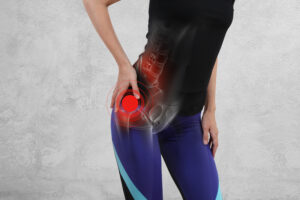 Arthritis of the Hip
Arthritis of the Hip
There are many types of arthritis of the hip but they all can result in the damage to and loss of the smooth articular cartilage of the hip joint. The hip is a ball and socket joint and when this cartilage damage begins to occur it can cause very severe pain and disability. When the cartilage in the hip degenerates to the point at which the bone beneath it is exposed, patients describe a grinding pain resulting from the unprotected bony surfaces rubbing on each other. As a result, our bones respond by growing large bone spurs that can cause pain as well as significantly reduce range of motion. Once non-operative treatment has failed, the surgical treatment for this condition is to replace the joint surfaces with an artificial hip (Total Hip Arthroplasty).
Our goal in Total Hip Arthroplasty is to improve pain and function with as little discomfort and limitation as possible. To do this (in appropriate patients) we perform the Anterior Approach. This surgical approach goes between the muscles in the front of the hip joint through a 10 cm incision. Other approaches (posterior, lateral) require varying degrees of detaching and reattaching muscles during the procedure which can cause more pain and instability which could increase the risk of dislocation. The anterior approach on the other hand has the lowest rate of dislocation and has very little limitation in activities from the day of surgery on.
Greater Trochanteric Bursitis
The outer bone around the hip joint that you can feel is called the Greater Trochanter and can be painful at times either from an injury or just greater than normal activity. If patients experience this pain, they may have Greater Trochanteric Bursitis. This pain occurs when the lubricating tissue on the outside of the hip (bursa) becomes inflamed or aggravated. This can be very painful and can radiate upward toward the pelvis and downward along the outside of the thigh. Many times activity limitation and nonsteroidal anti-inflammatory medications can address this condition effectively. Other times, very specific physical therapy or even a steroid injection can be helpful in treating this problem. In most cases patients are able to make a full recovery under the correct treatment plan. It is extremely rare to require surgical intervention for this condition.
Labral Degeneration
Labral degeneration refers to the wear and tear or breakdown of the labrum, which is a type of cartilage found in several joints in the body, most notably the shoulder (glenoid labrum) and hip (acetabular labrum). The labrum acts as a stabilizer, cushion, and facilitator for the range of motion within these ball-and-socket joints, effectively deepening the socket and securing the ball at the top of the bone snugly in place. Degeneration of the labrum can result from various factors, including aging, repetitive motion, or direct injury, leading to symptoms like pain, decreased range of motion, and joint instability. Labral degeneration can impair joint function significantly, necessitating medical evaluation and, in some cases, intervention to alleviate symptoms and restore joint health. Our approach to managing labral degeneration includes:
Diagnosis and Assessment: Comprehensive imaging and assessment to determine the extent of labral damage.
Conservative Treatment: Recommendations for rest, anti-inflammatory medications, and physical therapy aimed at strengthening the surrounding muscles.
Surgical Options: Arthroscopic surgery to repair or remove the damaged part of the labrum, offering a minimally invasive option with shorter recovery times.
Our surgeon works closely with physical therapists and other specialists to ensure a holistic approach to your recovery, aiming for the best functional outcome.
Avascular Necrosis (Osteonecrosis) of the Hip
Avascular Necrosis (AVN) of the hip, also known as Osteonecrosis, is a condition characterized by the death of bone tissue due to a lack of blood supply. This interruption to the blood flow can lead to the deterioration of the bone structure and may eventually cause the joint to collapse. The hip, a crucial weight-bearing joint, is one of the most commonly affected areas. AVN can occur due to a variety of reasons including trauma, long-term use of high-dose steroids, excessive alcohol consumption, and certain medical conditions. Early stages might not exhibit symptoms, but as the disease progresses, it can lead to pain, stiffness, and reduced mobility in the affected joint. Treatment options vary depending on the stage of the disease and can range from medication and physical therapy to surgical interventions such as bone grafts or joint replacement. Our treatment options for AVN include:
Conservative Treatments: Medications, physical therapy, and lifestyle modifications to manage symptoms.
Surgical Procedures: Core decompression to reduce pressure within the bone, bone grafting to support the hip joint, or total hip replacement for advanced cases.
Our team employs state-of-the-art diagnostic tools to accurately diagnose your condition and tailor a treatment plan that suits your specific needs.
